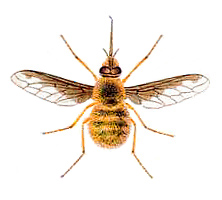
BUG OF THE MONTH: April 1996
Bee Flies of the genus Bombylius
Order Diptera, family Bombyliidae
Copyright © 1996 by Louise Kulzer
This article originally appeared in Scarabogram, April 1996, New Series No. 192, pp. 3-4.
"...the hairy and handsome harbingers of spring." --Frank R. Cole
I associate bee flies of the genus Bombylius with the first sunny warm days of spring - the first field excursion of the season. For bee flies do indeed fly early, generally March to May, just when the solitary bees are laying eggs in their ground burrows. Turns out this is more than a coincidence (stay tuned for the shocking details).
 |
| Bombylius major |
Bee flies get their common and scientific names from their superficial resemblance to bumblebees (family Bombidae). The genus Bombylius, in particular, are large, fuzzy flies with long legs, pictured wings, a notably long proboscis, and make a buzzing noise in flight, indeed resembling bumblebees. However, if you look closely you can tell they have only one pair of wings, and their antennae are entirely wrong for a bee. Unlike bumblebees, they're fast - really fast and agile, with great ability to hover, like syrphids.
While adult Bombylius feed on nectar from early spring flowers (and carry pollen, which they don't eat, on their fur), the larvae are parasitoids or predators on bee larvae. And now you know the shocking truth - Bombylius are out so early so they can stash their eggs in the open tunnels of solitary bees while they are still being provisioned and before they get sealed up.
When the female solitary bee goes in search of more leaves or pollen, the Bombylius hovers at the opening of the burrow. While still hovering, she ejects an egg inside the tunnel with a flick of her abdomen. I've seen bee flies work hillside locations - it may be easier for them to get the egg into a sideways tunnel (as hillside tunnels tend to be) than into a vertical one.
 |
|
| Active stage bee fly larva | Same larva after hypermetamorphosis |
Once inside the tunnel, the Bombylius larva emerges, worm-like and mobile. Sources I checked say it initially feeds on the provisions meant for the bee larvae, as do the bee larvae themselves. Later, the Bombylius larva changes its form (this is called hypermetamorphosis) into a more grub-like and sedentary creature that eventually turns carnivorous and attacks the bee larva itself (Oldroyd 1964; Cole 1969; Hull 1973). It wasn't clear whether it is an internal or external parasite at this point, for bee flies can be either. At any rate, when it's devoured the provisions and the bee larva or larvae (after all, most bees have multiple cells with a larva in each), it pupates, and emerges the next spring to start the cycle all over.
Bombylius are reported by Cole (1969) to parasitize certain Andrena, Colletes, and Halictus bees (mining, plasterer and sweat bees), but details are lacking. That same source also says they pollinate gilia and other deep throated flowers. Obviously, that's not too relevant for western Washington, huh? Western Washington species include Bombylius albicapillus and B. major, but I could find only sketchy information. Believe it, local observations are important.
Lest you get the wrong idea, let me mention that there are many other genera of bee flies with other characteristics. Most have parasitic larvae, but victimizing other insect groups.
[Cole lists about 75 species from Washington and Oregon, many in the genus Villa which has scales as well as hairs. Many bee flies, like Bombylius, victimize burrowing insects, not only solitary bees but digger wasps, tiger beetles, antlions, etc.; a number parasitize cutworms and other moth larvae, though not butterflies; quite a few attack grasshopper egg pods; a few are hyperparasites on larvae of ichneumonid wasps and tachinid flies which are already parasitizing something else. An African species parasitizes the tsetse fly.]
A closely related family, the Acroceridae, even parasitizes spiders. [Both families, together with the Asilidae (robber flies) and Tabanidae (horse flies) belong to the group Brachycera, flies which are more fly-like, as opposed to the mosquito-like Nematocera, as adults but have naked pupae.]
Look for bee flies in parks, gardens, meadows and open fields, especially on slopes, and especially if you notice a bee that just seems too fast for a bee! If you can, follow it and find out what flowers are used for nectar, what species of bee it's parasitizing, and then try to catch the bugger and its host and key them out! Then write it all down in your field notebook. And, if you're in the Scarabs, submit a report to the newsletter, where all this good local information can be shared!
Here's to spring, observation and the survival of the fittest!
References
Cole, Frank R. 1969. The Flies of Western North America. University of California Press, Berkeley.
Hull, Frank M. 1973. Bee Flies of the World. Smithsonian Institution Press.
Oldroyd, Harold. 1964. The Natural History of Flies. Weidenfeld and Nicolson, London.
This page last updated 16 June, 2005